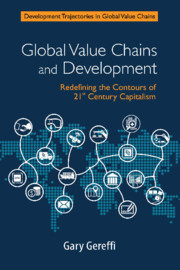Book contents
- Frontmatter
- Dedication
- Contents
- List of Tables
- List of Figures and Boxes
- Foreword
- Acknowledgments
- Sources
- 1 The Emergence of Global Value Chains: Ideas, Institutions, and Research Communities
- Part I Foundations of the Global Value Chain Framework
- Part II Expanding the Governance and Upgrading Dimensions in Global Value Chains
- Part III Policy Issues and Challenges
- 11 Global Value Chain Analysis: A Primer (Second Edition)
- 12 Global Value Chains, Development, and Emerging Economies
- 13 Risks and Opportunities of Participation in Global Value Chains
- 14 Global Value Chains in a Post-Washington Consensus World
- 15 Protectionism and Global Value Chains
- Co-authors
- Index
15 - Protectionism and Global Value Chains
from Part III - Policy Issues and Challenges
Published online by Cambridge University Press: 09 November 2018
- Frontmatter
- Dedication
- Contents
- List of Tables
- List of Figures and Boxes
- Foreword
- Acknowledgments
- Sources
- 1 The Emergence of Global Value Chains: Ideas, Institutions, and Research Communities
- Part I Foundations of the Global Value Chain Framework
- Part II Expanding the Governance and Upgrading Dimensions in Global Value Chains
- Part III Policy Issues and Challenges
- 11 Global Value Chain Analysis: A Primer (Second Edition)
- 12 Global Value Chains, Development, and Emerging Economies
- 13 Risks and Opportunities of Participation in Global Value Chains
- 14 Global Value Chains in a Post-Washington Consensus World
- 15 Protectionism and Global Value Chains
- Co-authors
- Index
Summary
These are extremely unsettled times in the global economy. In a referendum on June 23, 2016, the British electorate voted to leave the European Union (Brexit), and on November 8, 2016, Donald Trump won the US presidential election on the basis of an ‘America First’ doctrine that could potentially undermine a broad range of economic, political, and military partnerships that previous US administrations have been building since the end of the Second World War. Taken together, Brexit and the election of Donald Trump portend to some ‘the end of the Anglo-American order’ (Buruma, 2016), a grand alliance that presumed that a Pax Americana, along with a unified Europe, would keep the democratic world safe and capitalist economies prosperous. Instead of the triumph of Anglo-American exceptionalism, the current ‘taking back our country’ mantra of both English and American nationalists signals a retreat from the world that Anglo-Americans envisioned after 1945.
Meanwhile, just a few days before the inauguration of newly elected US president Trump, China's President Xi Jinping was at the World Economic Forum's annual meeting in Davos, Switzerland, proclaiming himself the new champion of free trade and globalization. Klaus Schwab, the founder of the World Economic Forum, endorsed China's willingness to take over this mantle from an apparently faltering US in introducing President Xi: ‘In a world marked by great uncertainty and volatility, the international community is looking to China’ (Mishra, 2018). China's spectacular ascent from a relatively isolated, agrarian economy at the end of the 1970s to the world's leading exporter and second-largest economy (after the US) today is a complex story of globalization with Chinese characteristics. Xi's state-controlled market economy has almost none of the openness associated with classic notions of free trade. Instead, China has embraced a style of ‘nationalistic mercantilism’ that shares many similarities with earlier East Asian success stories like Japan, South Korea, and Singapore (Prestowitz, 2017). But China's unique claim to fame may have been its ability to shift from a labor-intensive, low-cost export strategy (‘a race to the bottom’) to a high-tech, innovation-driven strategy (‘a race to the top’) at an unprecedented speed and scale that disrupted the hitherto dominant economies in the West.
- Type
- Chapter
- Information
- Global Value Chains and DevelopmentRedefining the Contours of 21st Century Capitalism, pp. 429 - 452Publisher: Cambridge University PressPrint publication year: 2018
- 2
- Cited by

